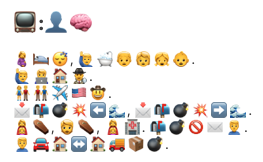 This assignment reminded me of the game Pictionary. When I typed out the story with emojis, I used one or two emojis to represent an idea. It was tough to find an emoji that represented one word. Retelling a story with emojis is more complex than writing a paper. Perhaps I have the mindset that others I do not communicate with regularly will read this. When I text my friends or send messages to my coworkers, expressing my thoughts with emojis is easier because they understand how and what I say.
This assignment reminded me of the game Pictionary. When I typed out the story with emojis, I used one or two emojis to represent an idea. It was tough to find an emoji that represented one word. Retelling a story with emojis is more complex than writing a paper. Perhaps I have the mindset that others I do not communicate with regularly will read this. When I text my friends or send messages to my coworkers, expressing my thoughts with emojis is easier because they understand how and what I say.
I started typing with emojis with the title. This allowed me to scroll through all the available emoji options and formulate “sentences” with emojis. I chose this work because this was the last piece I came into contact with. The story’s plot is very captivating, allowing me to be fully immersed in another reality. I did not think of the ease with that I or others can visualize the synopses.
Throughout this task, I kept thinking about the progression of human literacy, which felt like reverting to when I did not know how to write. As Bolter mentioned, there has been a push and strive for people to use the alphabet to express thoughts (2001). When reading a book, the author gives a smaller window for the reader to interpret the story. However, when someone looks at a piece of art, each person has a different interpretation of the artist’s expression, intention, and feeling. This is the same thing when a reader interprets the synopsis using emojis; each person has a different understanding of what each emoji can mean and will put together a different story. However, if we look at the emojis we use to communicate with people we regularly communicate with, there is a minimal chance of miscommunication because emojis are part of our everyday communication. The use of emojis helps enhance the conversation, convey emotions, and helps readers visualize the context. Interestingly, Sergeant says we will have communication problems because we regularly create new meanings with emojis (2019). There was even a push to have an emoji dictionary so users could have a common understanding of emoji phrases, so there would be fewer instances of miscommunication.
Reference:
Bolter, J. D. (2001). Writing space: Computers, hypertext, and the remediation of print (2nd ed.). Lawrence Erlbaum Associates.
Seargeant, P. (2019). The emoji revolution: how technology is shaping the future of communication. Cambridge University Press.